3 WAYS TO INCREASE PUSHUPS FOR
COAST GUARD BOOT CAMP
3 WAYS TO
INCREASE PUSHUPS
FOR
COAST GUARD
BOOT CAMP
FOLLOW THESE TIPS TO
IMPROVE YOUR PUSHUP GAME
FOLLOW THESE TIPS
TO IMPROVE
YOUR PUSHUP GAME
If you’re going to be attending Coast Guard Basic Training then you probably are already well aware that you’ll be doing LOTS of pushups during your 8 week stay. Pushups are a staple of Morning PT (Physical Training). They are also frequently administered as a form of IT (Incentive Training), and of course you’ll be doing them when you are tested on the PFT (Physical Fitness Test) as well. It goes without saying that you should be banging out pushups like water when you arrive at the Cape May Training Center. So with that said, here are 3 ways to increase pushups for Coast Guard Boot Camp.
Use The 'Grease The Groove' Method
Use The
'Grease The Groove'
Method
Grease the groove? You mean like the guy below? Well, not exactly.
Sounds weird I know. The so-called ‘groove’ is the the neuro-muscular pathway that your motor neurons follow when they fire in order for you to be able to move your muscles. The more often they fire in a specific pattern, the more efficient that pattern becomes. It should also be added that you want them firing correctly. Using poor form is a great way to set yourself up for injuries down the line so always practice proper technique.
So how do we grease the groove then?
Grease the groove? You mean like this guy? Well, not exactly.
Sounds weird I know. The so-called ‘groove’ is the the neuro-muscular pathway that your motor neurons follow when they fire in order for you to be able to move your muscles. The more often they fire in a specific pattern, the more efficient that pattern becomes. It should also be added that you want them firing correctly. Using poor form is a great way to set yourself up for injuries down the line so always practice proper technique.
So how do we grease the groove then?

I’m glad you asked!
We grease the groove by taking approximately 50% of our max repetitions and performing many sets of this number throughout the day with at least 20 minutes or more rest between each set.
For example’s sake, let us say that your max pushups without pausing is 60. To grease the groove, you would perform sets of 30 pushups randomly throughout the day. A good thing to do is pick a ‘total volume’ number. In this case maybe 300 to start. You would then do 10 sets of 30. Again make sure that the sets are spread out.
After 3-4 days you could increase the total volume to 420 (adding an extra 4 sets to your day). Every 9 or 10 days you’d want to taper down or take a rest day from this for a day or two and then start back up but with a slightly higher per set number (maybe 35 in this example).
The idea behind this strategy is that because you are always working at half your max, you never get burnt out. This allows you to maintain the large volume of work without getting too sore or fatigued. Of course if you are completely new to fitness or haven’t worked out in a while then you will likely feel it more than someone who’s been training regularly, but it still won’t be as bad as if you went all out on your workout.
Greasing the groove works amazingly well to increase rep numbers on most exercises – including pushups. Give it a shot!
Incorporate 'Gymnast Pushups' Into Your Training
Incorporate
'Gymnast Pushups'
Into Your Training
What’s the difference between a ‘regular’ pushup and a gymnast one?
I’ll dive into the details in just a second but to put it simply, gymnast style pushups are harder, engage more muscles, and build more strength. Let’s say you get to the point where you can perform the minimum number of reps required to pass the PFT but every rep is done in gymnast style fashion, then doing that same number using regular form will be a breeze.
In order to understand the difference between the two, you need to look at three things: the feet, the pelvis, and the scapula (shoulder blade).
What’s the difference between a ‘regular’ pushup and a gymnast one?
I’ll dive into the details in just a second but to put it simply, gymnast style pushups are harder, engage more muscles, and build more strength. Let’s say you get to the point where you can perform the minimum number of reps required to pass the PFT but every rep is done in gymnast style fashion, then doing that same number using regular form will be a breeze.
In order to understand the difference between the two, you need to look at three things: the feet, the pelvis, and the scapula (shoulder blade).
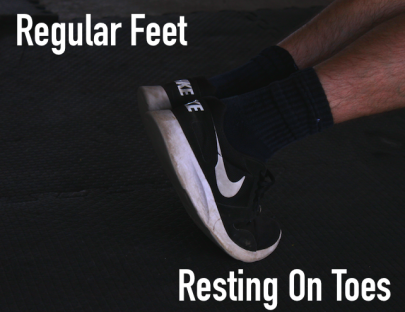
In a traditional pushup, we rest our body on our palms and on our toes. A gymnast style pushup has you flip your toes down so that your body is resting on the top of your foot. This affects the weight distribution of the pushup. Your toes are no longer absorbing a part of your body weight and as a result your upper body has to take on more of the load to make up for it.
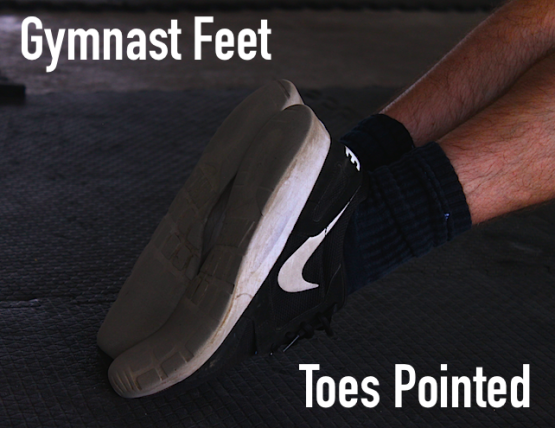
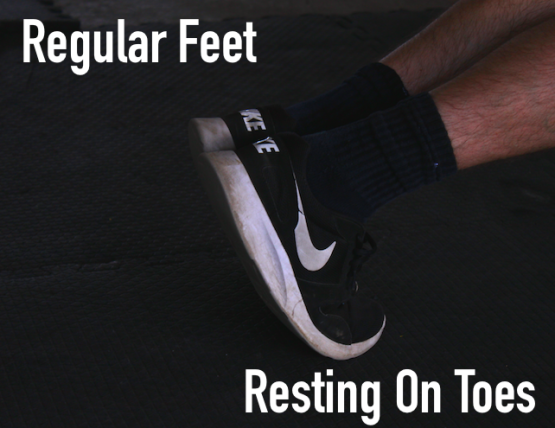
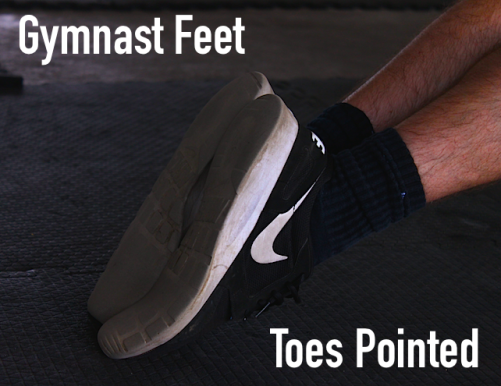
You’ll notice that when you do this, your body will naturally want to curl your feet so it can make things easier again by having a stable rest point, but you have to actively point your toes forward to prevent that from happening. This will keep the upper body pushing muscles working harder.
As far as the pelvis. In a standard pushup, your body naturally goes into an anterior pelvic tilt. In a gymnast style pushup, you engage your core and your glutes (butt cheeks) to create a posterior pelvic tilt. This not only forces your core and your glutes to work harder, but it also turns your body into a more solid, stable plank.
You’ll notice that when you do this, your body will naturally want to curl your feet so it can make things easier again by having a stable rest point, but you have to actively point your toes forward to prevent that from happening. This will keep the upper body pushing muscles working harder.
As far as the pelvis. In a standard pushup, your body naturally goes into an anterior pelvic tilt. In a gymnast style pushup, you engage your core and your glutes (butt cheeks) to create a posterior pelvic tilt. This not only forces your core and your glutes to work harder, but it also turns your body into a more solid, stable plank.
The easiest way to see the difference between an anterior pelvic tilt (regular pushup) and a posterior pelvic tilt (gymnast style) is by looking at the lower back. In an anterior pelvic tilt, your lower back will have a slight dip or indent, whereas in a posterior pelvic tilt, your back will make a nice straight line from the lower back all the way up to the top of your shoulders. See below to spot the difference.
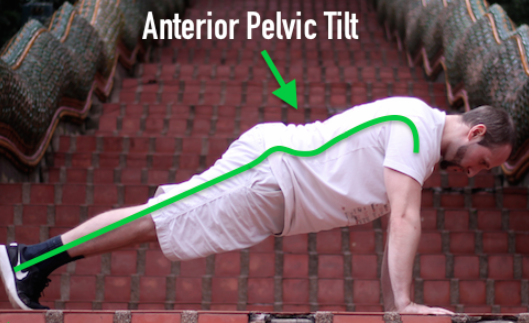
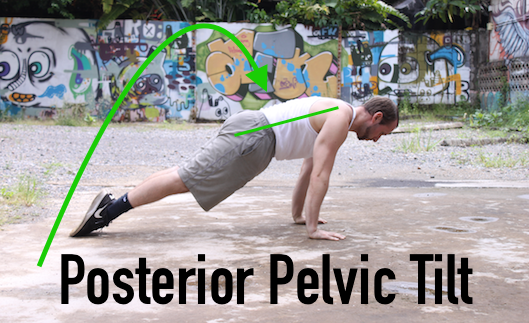
Lastly, we have the scapulae, better known as the shoulder blades. Mechanically speaking, when you perform a pushup – regular or gymnast – your shoulder blades naturally retract on the way down and protract on the way up. The slight difference with the gymnast style pushup is that you want to consciously protract at the very top so you really feel the squeeze. It will almost create this hilltop look if looked at from the front. Don’t allow your torso to just start sinking into the floor. Really think about what your shoulder blades are doing and you should be able to feel them spreading apart as you push the ground away from you at the top of the pushup.
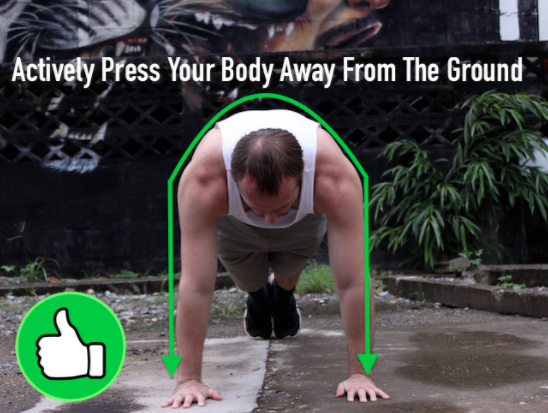

Play With Time
There are a number of ways you can do this but the end result will all be an increase in pushups for Coast Guard Boot Camp. Once you understand the concept, you can play around and tweak it to make it work for you.
The basic premise behind this strategy is that you are increasing time under tension.
If you don’t have one already, download an interval timer to your phone (I use ‘Gym Boss’) and set up 6 intervals of 10 seconds each for 3 rounds total. Gym Boss lets you color code each interval. Make the first 5 the same color and the last one a different color.

There are a number of ways you can do this but the end result will all be an increase in pushups for Coast Guard Boot Camp. Once you understand the concept, you can play around and tweak it to make it work for you.
The basic premise behind this strategy is that you are increasing time under tension.
If you don’t have one already, download an interval timer to your phone (I use ‘Gym Boss’) and set up 6 intervals of 10 seconds each for 3 rounds total. Gym Boss lets you color code each interval. Make the first 5 the same color and the last one a different color.
You will then do the following:
Perform 5 pushups at the start of the very first interval. Rest in the top part of the pushup position for a few seconds. Then when you hear the beep for the next 10 second interval, do another 5 pushups. Rest again in the top part of the pushup position.
Repeat this for all 6 intervals. When the 2nd round / 7th interval starts, do 4 pushups. Repeat in the same fashion just like above. Then at the start of the 3rd round, switch to 3 reps every 10 seconds.
By the time the 3 minutes is up, you’ll have performed 72 pushups without getting out of the pushup position. First round is 6 x 5 reps = 30. Second round is 6 x 4 = 24. Third round is 6 x 3 = 18. Add them all up and you get 72.
Take a few minutes rest and when you’re ready, do it again but lower each round by 1 rep. So do a 4, 3, 2 pyramid. Then rest again and repeat one last time with a 3, 2, 1 pyramid.
Keep in mind that this is one of an infinite number of ways you can play with this concept. If the way I described it above is too easy, you can start off with a higher rep number. Maybe do 6 reps every 10 seconds instead of 5. You can also increase the number of rounds. Instead of doing 3 rounds totalling 3 minutes. Do 4 rounds with a 5, 4, 3, 2 rep scheme. Play around with it and find what works for you.
One final note about this strategy: if you find yourself in the middle of a set where you physically can’t do another pushup, then simply lock out at the top and hold the plank until you can jump back in at some point before time is up. If you can’t jump back in at all, then simply stay in the plank until you hear the final beep. If you need to occasionally hike your hips up, do so, but don’t stay there forever. The key is to never get out of the pushup position until all the rounds are completed.
I hope you found this lesson on how to increase pushups for Coast Guard Boot Camp helpful. I could go on and on about pushups forever and there will probably be a part two to this at some point because these aren’t the only 3 strategies you can use but they certainly work.
Give them a shot and let me know how you fare with them. If you have Instagram, upload your pushup video and tag @uscgbootcamp with #survivecoastguardbootcamp and I’ll repost it.
In the meantime, there are all sorts of other topics to read about on this site that will help you prepare for USCG Boot Camp. These range from swimming in Coast Guard Basic Training to understanding what failing in Coast Guard Boot Camp really means. Read them all so you show up ready on day ZERO ONE.
Lastly, if you want an 8 week program designed for your fitness level that will get you physically ready for Coast Guard Basic Training, then check out my Coast Guard Boot Camp Fitness Success Programs.
Thanks for your support!
Semper Paratus!
Learn More
Show Up With The Knowledge
Of A Week 08 Recruit
Show Up
With The Knowledge